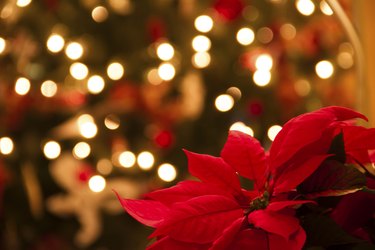
Rooting stem cuttings is the best way to propagate a poinsettia (Euphorbia pulcherrima), but rooting any kind of cutting is legal only when the plant isn't a patent-protected variety. Growing a poinsettia from a seed is possible, but the resulting plant is unlikely to produce seeds or to look like its parent plant. Poinsettia also doesn't propagate well from root cuttings. Usually grown indoors, poinsettias survive outdoors all year in U.S. Department of Agriculture plant hardiness zones 9 through 11, and you can take cuttings from indoor or outdoor plants. If you're unsure whether your poinsettia is patent-protected, ask at the store where you bought it. Wear gloves when touching the plant because its sap may cause an allergic reaction in some people, particularly people who are allergic to latex.
Taking Cuttings
Video of the Day
Before and after taking cuttings, sterilize pruning shear blades by wiping them with a cloth that's been dipped in rubbing alcohol, which helps prevent the spread of plant pests and diseases. Prune the poinsettia plant's old stems, cutting them where they join the main stem, and wait for new growth to appear. When the new stems are 4 inches long and have at least two or three mature leaves, select the thickest, healthiest ones, and cut them at their bases. Morning is the best time of day to take cuttings. Pull off excess leaves from the lower portions of the cuttings, leaving two or three leaves on the upper portion of each stem. Place the cuttings in tepid water for one hour, which helps stop sap from dripping from the cut ends.
Video of the Day
Placing Cuttings in Pots
Fill a 5-inch-diameter plant pot, which has bottom drainage holes, with a freely draining potting soil, such as a mixture that is half peat moss and half perlite mix. Poke four holes in the potting soil about 1 inch from the edge of the pot, equally spacing them from each other, and ensure that each hole is large enough to hold one stem cutting. A chopstick or pencil is about the right size for this task. Dip the lower quarter of each cutting in rooting hormone powder or liquid, and carefully place each cutting 1 to 2 inches deep in its own hole. Gently push the potting soil around the cuttings to close any gaps and to hold the cuttings upright.
Providing Humidity and Light
Water the cuttings slowly to avoid dislodging them from the soil. When water drips through the pot's drainage holes, stop watering and allow the pot to drain thoroughly. Place a clear, plastic bag over the cuttings and pot. The bag should be large enough so that it doesn't touch the leaves or stems of the cuttings. Tie the bag loosely around the pot with twine and place the pot in a brightly lit area, such as a sunny windowsill or home greenhouse. The inside of the plastic bag may become covered in condensation, but this is nothing to worry about. When the soil surface is dry, remove the bag and water the cuttings.
Transplanting Cuttings
Poinsettia cuttings are usually ready for transplanting in three to four weeks. By that time, they should have well-developed roots that are at least 1/2 inch long. Fill 3-inch-diameter plant pots that have bottom drainage holes with freely draining potting soil, and poke a planting hole in the soil at the center of each pot to accommodate one rooted cutting. Remove the plastic bag from the larger pot, and gently ease a cutting out with the help of a chopstick or pencil, retaining as much of the original potting soil around the roots as possible. Place the cutting in its own new pot at the same soil depth at which it grew previously, and gently firm the soil around the cutting. Then water the soil until it drips through the bottom drainage holes. Transplant the remaining cuttings in the same way, and place the transplanted cuttings in a brightly lit, warm area.
- New Mexico State University College of Agricultural, Consumer and Environmental Sciences: Propagating Poinsettias From Cuttings
- Missouri Botanical Garden: Euphorbia Pulcherrima
- New Mexico State University Cooperative Extension Service: Poinsettias -- Year after Year
- National Gardening Association: Growing Poinsettias Outside
- University of Florida Extension: Poinsettias for Florida, Indoors and Outdoors